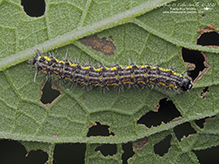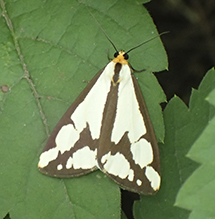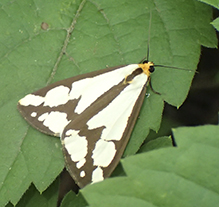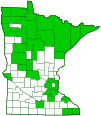confused haploa
(Haploa confusa)
Conservation • Description • Habitat • Ecology • Distribution • Taxonomy
|
||||||||
| Hodges # | 8112 |
|||||||
Conservation Status |
||||||||
| IUCN Red List | not listed |
|||||||
| NatureServe | NNR - Unranked SNR - Unranked |
|||||||
| Minnesota | not listed |
|||||||
Description |
||
Confused haploa is a common, broad-winged, flimsy-looking, tiger moth. It occurs in the United States from Maine to virginia, west to Minnesota, Missouri, and Oklahoma, and in southern Canada from Nova Scotia to Manitoba. The larvae feed on the foliage of many herbaceous and woody plants. Adults are found from June through August in woodlands, fields, and gardens. Adults are ¾″ to ⅞″ (20 to 22 mm) in length and have a 1 7⁄16″ to 1⅝″ (37 to 42 mm) wingspan. The head and collar are orangish-yellow. There are two brown spots in the middle of the collar. The spots are sometimes flanked by white. The eyes are black. The antennae on both the male and female are black, slender, and thread-like. The upper side of the thorax is mostly white, yellow at the rear, with a broad, dark brown, longitudinal stripe in the middle. The upper side of each abdominal segment has a narrow dark brown longitudinal stripe in the middle. The first and eighth segments are yellow. Segments two through seven are white with a narrow yellow band at the rear. The wings are held over the body like a roof when at rest, giving the moth a distinctly triangular shape. The forewings are creamy white and dark brown (dark). They are described by some authors as dark with white spots, by other authors as white with dark lines. On each forewing, the inner margin, outer margin, and leading edge (costal margin) are dark except at the wingtip. Inside the margins there are five or six large white spots and two or three small white spots on a dark background. The size and pattern of spots is highly variable, resulting in this moth being described as a few different species, or as subtypes of other species. Generally, there is one large spot at the base, one in the front half and one in the rear half of the median area, one at the wingtip (apical), and one on the outer margin. The basal spot is oblong. The inner median spot may be slightly or deeply cleft. Occasionally it is separated into two distinct spots. Sometimes it is fused with the basal spot, creating one long spot that is cleft at the base. The outer median spot is usually nearly round. The apical spot is oval or oblong and is occasionally connected to the outer median spot. The outer margin spot is large and more or less triangular. Sometimes it is broken into several spots. The hindwings are white and usually unmarked. Occasionally there is a single small dark spot near the inner (anal) angle. The legs are orangish-yellow on the lower (inner) side. The first segment (coxa) of the front legs has a black spot. On the front and middle legs, the upper (outer) side of the third segment (femur), fourth segment (tibia), and the last part of the leg (tarsus), corresponding to the foot, are all dark brown. The caterpillar is mostly black with a narrow stripe down the middle (middorsal stripe), a wider stripe on each upper side (subdorsal stripes), and a stripe on each lower side that passes through the breathing pores (spiracular stripe). The middorsal stripe is bright yellow with white areas at the margins of the abdominal segments. It is sometimes bold, sometimes indistinct, and occasionally missing. The subdorsal stripes are bright yellow and are often constricted or broken in the middle of each abdominal segment. The spiracular stripes are bright yellow and are mostly broken into a row of spots. Each abdominal segment has six large black warts with a cluster of relatively short, barbed, bristle-like structures (setae). The upper (dorsal) setae are black, those on the sides are whitish. |
||
Size |
||
Total length: ¾″ to ⅞″ (20 to 22 mm) Wingspan: 1 7⁄16″ to 1⅝″ (37 to 42 mm) |
||
Similar Species |
||
Habitat |
||
Woodlands, fields, and gardens |
||
Ecology |
||
Season |
||
One generation per year: June through August |
||
Behavior |
||
The wings are held over the body like a roof when at rest. |
||
Life Cycle |
||
Caterpillars overwinter and pupate in the spring. |
||
Larva Hosts |
||
The original description of confused haploa by H. H. Lyman in 1887 mentioned larvae feeding on hound’s tongue. Some sources, including BugGuide.net, Field Guide to Moths of Eastern North America (Covell, 2005), and Peterson Field Guide to Moths of Northeastern North America (Beedle & Leckie, 2012), list this as the only food source for this caterpillar. Observations since the original description indicate that confused haploa is polyphagous, meaning that it feeds on many herbaceous and woody plants. |
||
Adult Food |
||
|
||
Distribution |
||||
|
Sources |
|||
| 4/9/2023 | ||||
Occurrence |
||||
Common |
||||
Taxonomy |
|||
Order |
Lepidoptera (Butterflies and Moths) | ||
Superfamily |
Noctuoidea (Owlet Moths and Allies) | ||
Family |
Erebidae (Underwing, Tiger, Tussock, and Allied Moths) | ||
Subfamily |
Arctiinae (tiger moths and allies) | ||
Tribe |
Arctiini (tiger moths) | ||
| Subtribe | Callimorphina | ||
Genus |
Haploa | ||
In 2011 the family Arctiidae (tiger moths and lichen moths) was transferred to the family Erebidae mostly intact but demoted to a subfamily. The former subfamilies are now tribes, the former tribes now subtribes. |
|||
Synonyms |
|||
Callimorpha confusa Haploa lymani Haploa triangularis Hypercompa Lecontei |
|||
Common Names |
|||
confused haploa confused haploa moth |
|||
Glossary
Anal angle
In insects: The angle at the corner of a wing formed where the outer and inner margins meet.
Costal margin
The leading edge of the forewing of insects.
Coxa
The first segment of the leg of an insect, attaching the leg to the body, and connected to the trochanter. Plural: coxae
Femur
On insects and arachnids, the third, largest, most robust segment of the leg, coming immediately before the tibia. On humans, the thigh bone.
Seta
A stiff, hair-like process on the outer surface of an organism. In Lepidoptera: A usually rigid bristle- or hair-like outgrowth used to sense touch. In mosses: The stalk supporting a spore-bearing capsule and supplying it with nutrients. Plural: setae. Adjective: setose.
Tarsus
On insects, the last two to five subdivisions of the leg, attached to the tibia; the foot. On spiders, the last segment of the leg. Plural: tarsi.
Tibia
The fourth segment of an insect leg, after the femur and before the tarsus (foot). The fifth segment of a spider leg or palp. Plural: tibiae.
Visitor Photos |
|||||
Share your photo of this insect. |
|||||
| This button not working for you? Simply email us at info@MinnesotaSeasons.com. Attach one or more photos and, if you like, a caption. |
|||||
Alfredo Colon |
|||||
 |
|||||
Babette Kis |
|||||
Haploa confusa (confused haploa) |
|||||
 |
 |
||||
MinnesotaSeasons.com Photos |
|||||
|
|||||

Visitor Videos |
|||
Share your video of this insect. |
|||
| This button not working for you? Simply email us at info@MinnesotaSeasons.com. Attach a video, a YouTube link, or a cloud storage link. |
|||
Other Videos |
|||

Visitor Sightings |
|||||
Report a sighting of this insect. |
|||||
| This button not working for you? Simply email us at info@MinnesotaSeasons.com. Be sure to include a location. |
|||||
| Alfredo Colon 8/21/2022 |
Location: Albany, NY |
||||
| Babette Kis 7/2/2022 |
Location: Barnes Prairie near hedgerow, Racine Co., WI |
||||
MinnesotaSeasons.com Sightings |
|||||
|
|||||

Created: 4/9/2023
Last Updated:




